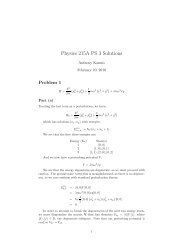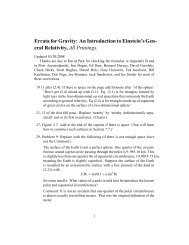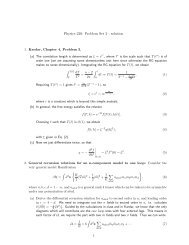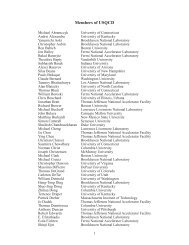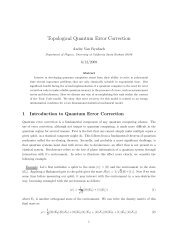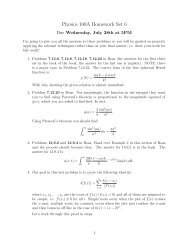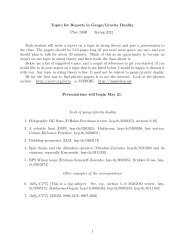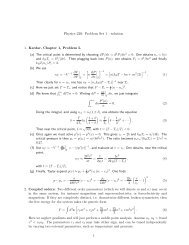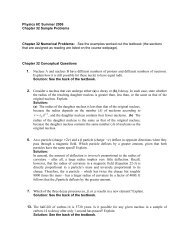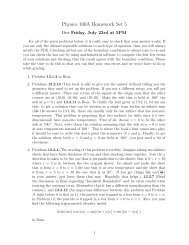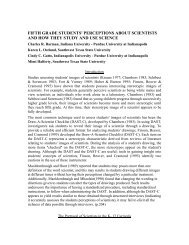Nuclear Spectroscopy
Nuclear Spectroscopy
Nuclear Spectroscopy
You also want an ePaper? Increase the reach of your titles
YUMPU automatically turns print PDFs into web optimized ePapers that Google loves.
SUPPLIES<br />
• NaI(Tl) detector with MCA<br />
• Radioactive sources: 22 Na, 54 Mn, 60 Co, 65 Zn, 88 Y,<br />
133<br />
Ba, 134 Cs, 137 Cs, 207 Bi<br />
SUGGESTED EXPERIMENTAL PROCEDURE<br />
1. Start the MCA and check the calibration using<br />
the 137 Cs source. The observed photopeak should<br />
be centered near 661.6 keV. If it is not within 10<br />
keV of the accepted value, you may need to<br />
recalibrate your system.<br />
2. Place another source on the fourth shelf under<br />
the detector and acquire a spectrum with the full<br />
vertical scale at 1,000 counts.<br />
3. Select a Region Of Interest (ROI) around your<br />
photopeak. Details for doing this are in Appendix<br />
A. Record the centroid of the photopeak and<br />
its FWHM. This is available to you by displaying<br />
the Peak Summary, or for the ROI where the<br />
cursor is located, by selecting the Display Region<br />
button to the right of the displayed spectrum.<br />
4. Repeat step 3 for all the sources available to you.<br />
You may use all the data from Experiment #2 to<br />
avoid retaking spectra.<br />
DATA ANALYSIS<br />
From your data of photopeak energies and corresponding<br />
FWHM calculate the fractional resolution<br />
and graph its square as a function of the inverse of the<br />
corresponding photopeak energy. Use a linear least<br />
squares program to get the equation for the best<br />
straight line fit to your data. Graph this equation on<br />
the graph with your data. Is your fit to the data a good<br />
fit?<br />
Another way to test the theoretical explanations for<br />
the fractional resolution is to graph the natural logarithm<br />
of the fractional resolution as a function of the<br />
natural logarithm of the corresponding photopeak<br />
energy. Obtain the slope and intercept from a linear<br />
least squares fit to the data. From equation 3.1,we get<br />
the following<br />
Gamma Intensity<br />
40<br />
30<br />
20<br />
10<br />
0XXXX<br />
5%<br />
7.5%<br />
10%<br />
400 450 500 550 600<br />
Gamma Energy (keV)<br />
Figure 3.2 The overlapping spectra above are of two equalarea<br />
photopeaks centered at 477 keV and 511 keV. The<br />
individual photopeaks are shown at 10% resolution underneath<br />
the other spectra. The combination of the two photopeaks<br />
is shown for resolutions of 5%, 7.5%, and 10%.<br />
which predicts the slope to be -0.5. How well does<br />
your experimentally determined slope compare to<br />
the expected value of -0.5?<br />
NE ( ) =<br />
N<br />
0<br />
2πσ<br />
2 2<br />
−( e E − E m ) / 2σ<br />
2<br />
original peaks<br />
This is the equation for the normal (Gaussian)<br />
distribution with a peak area of N 0<br />
. The average<br />
energy is E m<br />
and σ is the standard deviation<br />
of that average. The FWHM = 2.3548 σ. See<br />
Experiment #9 for more information.<br />
3.3<br />
⎛ ∆E⎞<br />
E<br />
ln ln ln E . lnE<br />
⎝ E ⎠ ∝ ⎛ ⎝ ⎜ ⎞<br />
E<br />
⎟<br />
⎠<br />
= ⎛ − 1 2 ⎞<br />
⎝ ⎠<br />
=−05<br />
13




